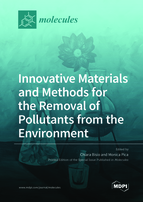Innovative Materials and Methods for the Removal of Pollutants from the Environment
A special issue of Molecules (ISSN 1420-3049). This special issue belongs to the section "Green Chemistry".
Deadline for manuscript submissions: closed (31 December 2020) | Viewed by 70581
Special Issue Editors
Interests: development of innovative materials for the catalytic abatement of toxic molecules; novel catalysts for green processes; optimization of porous sorbents for CO2 capture and/or water decontamination; novel materials for the production of energy through processes with low environmental impact; preparation of inorganic and hybrid organic-inorganic additives for polymer nanocomposites
Special Issues, Collections and Topics in MDPI journals
Interests: zirconium phosphate based materials; treatment of wastewater
Special Issues, Collections and Topics in MDPI journals
Special Issue Information
Dear Colleagues,
In the last decade, environmental pollution has reached worrying proportions, and intensive efforts have been devoted to seeking solutions that can be effectively employed for the removal of pollutants from different environmental compartments.
This Special Issue aims to gather the most recent and significant contributions related to innovative materials and processes for environmental purposes, with special emphasis on the depollution of air, water, and soil.
Novel applications of inorganic, organic, or hybrid materials with porous or layered structures for the removal of pollutants through adsorption processes and/or (catalytic) transformation of noxious compounds into species with reduced environmental impact will be of special interest. This Special Issue will include, but is not limited to, new synthetic and characterisation methods for the production of cheap and environmentally friendly materials, as well as characterisation methods for and investigations on pollutant removal processes (with applications to synthetic and real effluents), by experimental and theoretical techniques.
Contributions concerning the removal and/or transformation of emerging contaminants (i.e., synthetic or naturally occurring chemicals not commonly monitored in the environment but with potential or suspected adverse ecological and/or human health effects), such as pesticides or pharmaceuticals, industrial chemicals, surfactants, and personal care products, are strongly encouraged
Prof. Chiara BisioDr. Monica Pica
Guest Editors
Manuscript Submission Information
Manuscripts should be submitted online at www.mdpi.com by registering and logging in to this website. Once you are registered, click here to go to the submission form. Manuscripts can be submitted until the deadline. All submissions that pass pre-check are peer-reviewed. Accepted papers will be published continuously in the journal (as soon as accepted) and will be listed together on the special issue website. Research articles, review articles as well as short communications are invited. For planned papers, a title and short abstract (about 100 words) can be sent to the Editorial Office for announcement on this website.
Submitted manuscripts should not have been published previously, nor be under consideration for publication elsewhere (except conference proceedings papers). All manuscripts are thoroughly refereed through a single-blind peer-review process. A guide for authors and other relevant information for submission of manuscripts is available on the Instructions for Authors page. Molecules is an international peer-reviewed open access semimonthly journal published by MDPI.
Please visit the Instructions for Authors page before submitting a manuscript. The Article Processing Charge (APC) for publication in this open access journal is 2700 CHF (Swiss Francs). Submitted papers should be well formatted and use good English. Authors may use MDPI's English editing service prior to publication or during author revisions.
Keywords
- Environmental depollution
- Adsorption processes
- Catalytic decontamination
- Porous and layered materials
- Characterization methods








